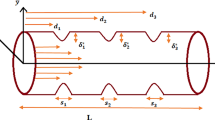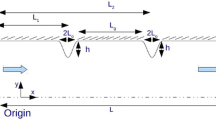Abstract
To understand the special flow conditions which may be produced by the presence of stenosis in arteries, an analytical solution is obtained for pulsatile laminar flow in an elliptic tube. Blood is approximated by a Newtonian model and the geometry of the stenosis is introduced by specifying the change in area of cross-section of the stenosed artery with axial distance. The results for velocity, pressure, shear stress and impedance are presented. These are compared with the steady flow results as well as with those of the flow in a stenosed tube of circular cross-section. The study indicates that the fluid dynamic characteristics of the flow are affected by the percentage of stenosis as well as the geometry of the stenosis. The frequency of oscillation is also found to influence shearing stress and the impedance.
Similar content being viewed by others
References
Attinger, E. O. (1963) Transmission in pulmonary arteries.Circ. Res.,12, 623–641.
Caro, C. G. andSaffman, P. G. (1965) Extensibility of blood vessels in isolated rabbit lungs.J. Physiol.,178, 193–210.
Caro, C. G., Fitz-Gerald, J. M. andSchroter, R. C. (1971) Atheroma and arterial wall shear-observation, correlation and proposal of a shear dependent mass transfer mechanism for Atherogensis.Proc. R. Soc. London,B177, 109–159.
Caro, C. G., Pedley, T. J., Schroter, R. C. andSeed, W. A. (1978)The mechanics of the circulation. Oxford University Press, New York, 346.
Clark, C. (1976) The fluid mechanics of aortic stenosis: II unsteady flow experiments.J. Biomech.,9, 567–578.
Daly, B. J. (1976) A numerical study of pulsatile flow through stenosed canine femoral arteries.,9, 465–475.
Deshpande, M. D., Giddens, D. P. andMabon, R. F. (1976) Steady laminar flow through modelled vascular stenoses.,9, 165–174.
Fry, D. L. (1969) Certain histological and clinical responses for the vascular interface to acutely induced mechanical stress in the artery of the dog.Circ. Res.,24, 93–108.
Lee, J. S. andFung, Y. C. (1970) Flow in a locally constricted tube at low Reynolds numbers.J. Appl. Mechs., Trans. ASME,37, 9–16.
Padmanabhan, N. (1980) Mathematical model of arterial stenosis.Med. & Biol. Eng. & Comput.,18, 261–266.
Pedley, T. J. (1980)The fluid mechanics of large blood vessels. Cambridge University Press, Cambridge.
Young, D. F. (1968) Etfect of a time dependent stenosis on flow through a tube.J. Eng. for Ind., Trans. ASME,90, 248–254.
Young, D. F. andTsai, F. Y. (1973) Flow characteristics in models of arterial stenosis: I steady flow.J. Biomech.,6, 394–410.
Author information
Authors and Affiliations
Rights and permissions
About this article
Cite this article
Mehrotra, R., Jayaraman, G. & Padmanabhan, N. Pulsatile blood flow in a stenosed artery—a theoretical model. Med. Biol. Eng. Comput. 23, 55–62 (1985). https://doi.org/10.1007/BF02444028
Received:
Accepted:
Issue Date:
DOI: https://doi.org/10.1007/BF02444028




